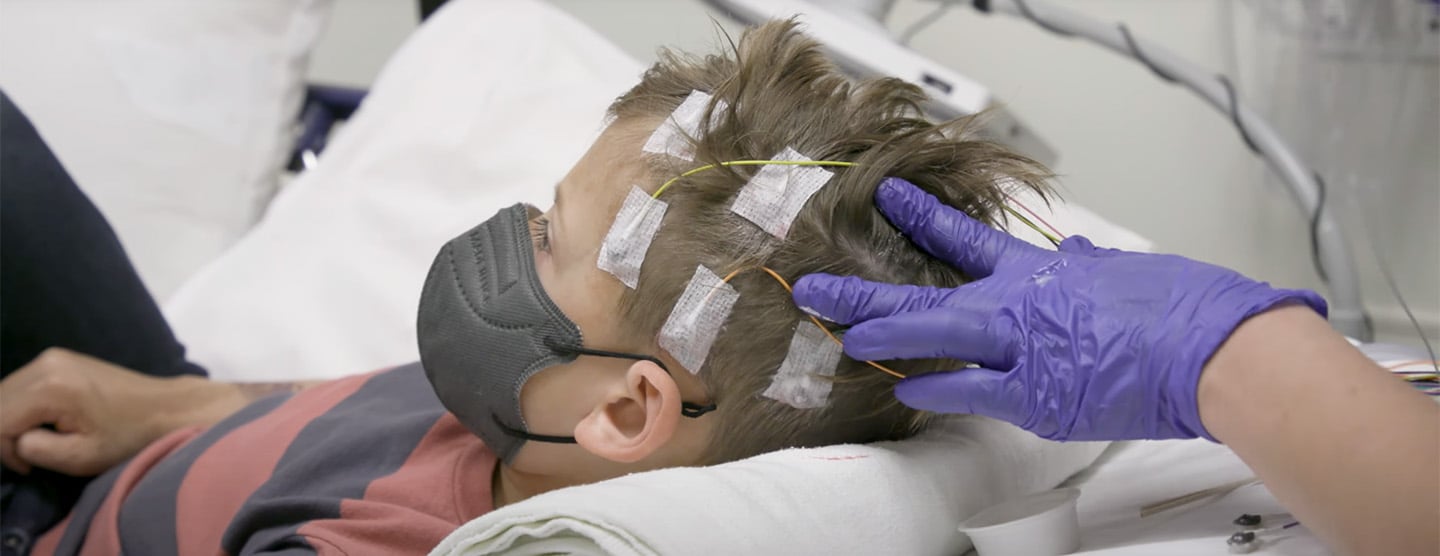To help diagnose your child's epilepsy, we may perform what's called electroencephalogram (EEG) video telemetry to monitor electrical activity of the brain and record a typical seizure or spell.
A standard EEG provides a snapshot of electrical activity in your child's brain and runs about 30 minutes. When a standard EEG doesn't provide enough information on the source and progression of seizures, continuous EEG video telemetry may be performed to learn more.
Each year, we monitor more than 350 children, the majority with uncontrolled epileptic seizures. Based on the results, more than half of our patients are given a new medication plan and an improved understanding of their seizures.
Here are some frequently asked questions about EEG video telemetry.
- How should I prepare my child for monitoring?
- What should we bring to the hospital?
- Where do we go when we arrive at UCSF Benioff Children's Hospital?
- What should we expect during the hospital stay?
- How is EEG video telemetry performed?
- Will the team update me on how things are going?
- Will the electrodes remain attached during the entire hospital stay?
- Will my child take anti-epileptic medication while in the hospital?
- How are the monitoring results used?
How should I prepare my child for monitoring?
Discussions about the procedure will depend on your child's age. Pre-school children, for example, do best with information a day or two before the event. Older children need more time to talk it over and think of questions. Generally, we believe it's best to give your child as much honest, simple and concrete information as he or she can understand. In addition:
- Develop a plan to decrease anxiety and promote coping.
- Give your child praise and support.
- Act out or discuss the procedure in advance, using dolls, drawings or role-play.
- Provide opportunities to discuss your child's experiences after monitoring is completed.
What should we bring to the hospital?
Please bring:
- A list of all medications your child is taking.
- Enough of each medication to last 24 hours after discharge. The hospital no longer dispenses discharge medications.
- Books, toys, snacks and videos to make your child more comfortable and help pass the time. Your child may need to stay awake all night to help bring on a seizure.
- Clothes and overnight supplies, such as a toothbrush and toothpaste, to last up to a week. Hospital pajamas are provided for your child but you may bring his or her own pajamas and light clothes. Please don't bring tops that must be pulled on or off your child's head since that may interfere with electrodes on the scalp.
- Contact information for any health care providers who should be notified of your child's test results.
- Your child's insurance card.
- A long-distance phone card or your own cell phone, if you plan to make long-distance calls.
Where do we go when we arrive at UCSF Benioff Children's Hospital?
UCSF Benioff Children's Hospital San Francisco is located at 1975 Fourth St. in San Francisco. Maps and directions are available online. There are several public parking facilities near the hospital, including a surface lot and the 1835 Owens St. garage.
Once you arrive, please check in at the admissions office, located on the first floor.
What should we expect during the hospital stay?
Your child's stay may range from one night to one week, depending on how long it takes to record a sampling of a seizure or spell. It can take several days for a seizure to occur for recording. We may ask you to help your child stay awake overnight since sleep deprivation can help induce seizure activity. If exercise or fatigue brings on your child's seizures, we may ask him or her to exercise on a padded mat.
We strongly recommend that a parent or other caregiver stay with your child while in the hospital. A chair that converts into a bed is available in each child's room. The room also has a telephone, television and private bathroom. Sitters are available for brief periods so you can take breaks and get meals. If a caregiver is not available to accompany your child, please let us know in advance so we can try to make alternate arrangements.
We recommend that only one caregiver stay overnight. We encourage siblings of all ages to visit, so long as they do not have a cough or cold. However, siblings are not allowed to stay overnight in the hospital room.
The hospital will provide meals for your child. For parents and others, there are cafes and cafeterias within the hospital, as well as restaurants nearby. You will have access to a small refrigerator and microwave on your child's floor.
If other family members need lodging, a family resource coordinator can provide assistance. Please call (415) 353-2016 for more information.
Please note that all UCSF facilities are smoke-free. Smoking in and around the hospital premises is prohibited.
How is EEG video telemetry performed?
EEG video telemetry occurs in two parts.
EEG Telemetry: Electrodes are glued to your child's scalp to record the brain's electrical activity. To make the glue adhere for an extended period, it's dried with bursts of air from a small air compressor. This can be loud and startling but doesn't hurt.
A computer continuously monitors the EEG recording so that seizure activity is marked and recorded, even if not obvious. This is important for children who have brief seizures or ones that occur during sleep.
Video Telemetry: A camera continuously records your child, allowing us to compare what physically occurs during a seizure with what is recorded by the EEG. This helps us accurately classify the seizure type.
The hospital room has a camera mounted on the ceiling at the foot of the bed — or crib depending on your child's age — and a microphone directly over the bed. The camera may be adjusted so your child can move from one area of the room to another. The EEG electrodes are attached to a 20-foot cord so he or she can go to the chair, play mat or bathroom.
A black button and a white button, which look like nurse call buttons, are clipped to the padded siderail of your child's bed. Push both as soon as you notice your child might be having a seizure or any "strange" feeling. The black button alerts the computer to mark and save what appears on the video and EEG. The white button notifies your nurse to examine your child during and after the seizure.
Your role is important since your child may alert you to an oncoming seizure before changes occur on the EEG. Your assistance may enable us to record the entire event.
To remain in range of the camera, your child must stay in his or her room, except when in the playroom during designated hours. Time in the playroom may vary, depending on availability. In the playroom, your child will be supervised by hospital staff and you do not need to be present.
Will the team update me on how things are going?
Your child's team will include a pediatric epileptologist, a nurse practitioner, a pediatric social worker, neurology fellows, pediatric residents, nurses, an EEG technologist and a child life specialist.
Team members will meet with you and your child daily to discuss the monitoring and to ensure you both are as comfortable as possible. If further monitoring, surgery or participation in an experimental drug trial are good options for your child, each option will be discussed in detail.
Will the electrodes remain attached during the entire hospital stay?
Yes, your child will be wearing the EEG electrodes during the entire stay. A child life specialist will be available to help calm or distract your child when the electrodes are applied. The glue has a strong odor, and once dry, it's itchy. We work to help your child adjust.
Wires from the electrodes are connected to a receiver unit, which is hooked up by cables to the computer. The electrodes are checked daily by an EEG technician to ensure they're working correctly. Electrodes aren't removed until the testing is complete. Most children find it easiest to wear tie-in-the-back hospital pajamas. Your child may wear his or her own pajamas if the top opens with buttons or a zipper.
Your child's hair won't be washed until the electrodes are removed. A special solution is used to remove the electrodes and glue.
Will my child continue to take anti-epileptic medication during the hospital stay?
Your child’s anti-epileptic medicines may be slowly decreased while in the hospital to help bring on a seizure. DO NOT taper your child's medications on your own, unless directed to do so by your doctor. Remember, your child will be under strict medical supervision so there's no need to worry about your child's safety.
An intravenous catheter may be inserted in your child's arm and capped, depending on his or her condition. If your child has severe or frequent seizures, we can stop them by administering emergency IV medicines. The catheter is checked daily by a nurse and changed as necessary. A child life specialist will be present as it's placed to help your child remain as comfortable as possible.
How are the monitoring results used?
The more accurately we are able to classify your child's seizure type, the better we are able to control the seizures with medication. For children who are having "spells" or behavior changes for unknown reasons, this test can characterize the episodes. The spells may be seizures or may have other physical or emotional causes unrelated to epilepsy.
EEG video telemetry helps localize a seizure focus in the brain, which is critical in determining if your child can be treated with surgery. Surgery is most successful when we have identified the precise area in the brain where seizures originate. Prolonged monitoring allows us to record a number of seizures. It may show us that a single area in the brain is producing seizures or that more than one area is involved. If the seizures originate in more than one area, the chances for successful surgery decrease considerably. Based on monitoring results, we may recommend additional tests or alternative treatments.































